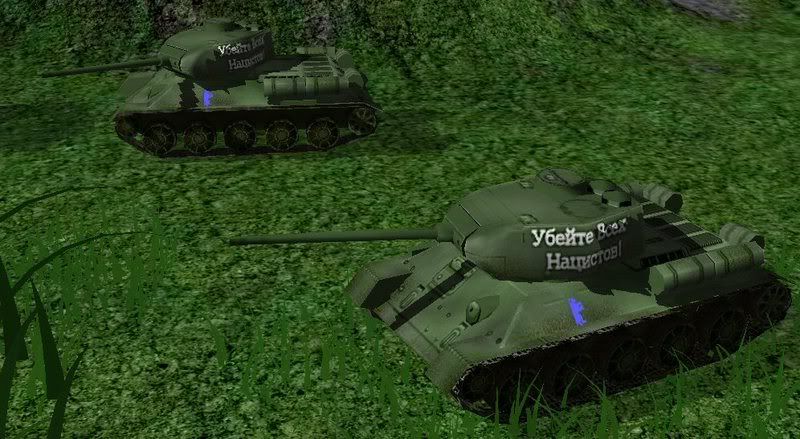Here is a demonstration model + script, you will need to write an fbi and stuff to make it work if you want to test it.


The idea is that every wheel has a spring that pushes against the hull of the vehicle, so it bumps around. The spring force is normally proportional to it's displacement. First off we need these objects and variables:
Code: Select all
#define TA // This is a TA script
#include "sfxtype.h"
#include "exptype.h"
piece ground, hull, turret, gun, flare, wheel1, wheel2, wheel3, wheel4, wheel5, wheel6, susp1, susp2, susp3, susp4, susp5, susp6, gs1, gs2, gs3, gs4, gs5, gs6;
static-var moving, xtilt, xtiltv, xtilta, ztilt, ztilta, ztiltv, ya, yv, yp, s1, s2, s3, s4, s5, s6, damp;
// Signal definitions
#define SIG_AIM 2
#define ANIM_VARIABLE Moving
#undef ANIM_VARIABLE Code: Select all
Suspension()
{
while(1)
{
s1 = get GROUND_HEIGHT(get PIECE_XZ(gs1)) - get PIECE_Y(gs1);
if(s1 < [-2])
{
s1 = [-2];
}
s2 = get GROUND_HEIGHT(get PIECE_XZ(gs2)) - get PIECE_Y(gs2);
if(s2 < [-2])
{
s2 = [-2];
}
s3 = get GROUND_HEIGHT(get PIECE_XZ(gs3)) - get PIECE_Y(gs3);
if(s3 < [-2])
{
s3 = [-2];
}
s4 = get GROUND_HEIGHT(get PIECE_XZ(gs4)) - get PIECE_Y(gs4);
if(s4 < [-2])
{
s4 = [-2];
}
s5 = get GROUND_HEIGHT(get PIECE_XZ(gs5)) - get PIECE_Y(gs5);
if(s5 < [-2])
{
s5 = [-2];
}
s6 = get GROUND_HEIGHT(get PIECE_XZ(gs6)) - get PIECE_Y(gs6);
if(s6 < [-2])
{
s6 = [-2];
}Anyway, now we need to take into consideration the different spring displacements. The force from the spring is proportional to this displacement. The force can act in different ways, either giving a linear acceleration, or rotational acceleration on the body, depending on how it's distributed among the wheels/springs. This is just a quick hack to get something that looks like real physics, so I have opted to simply guess some values until i found some that works:
Code: Select all
xtilta = 0 - (get ATAN(s1, [14]) - get ATAN(s3, [14]) + get ATAN(s4, [14]) - get ATAN(s6, [14]))/300 + xtiltv/7;
xtiltv = xtiltv + xtilta;
xtilt = xtilt + xtiltv*4;Computing the speed from the acceleration is straightforward, so is the actual tilt. Notice the *4 there, I found that experimenting with different values here will change the amplitude/frequency in a different way then changing the constant in the acceleration formula itself (/300 here). Then we compute the other tilts, and the displacement, in a similar fashion:
Code: Select all
ztilta = 0 - (get ATAN(s1, [14]) + get ATAN(s2, [14]) + get ATAN(s3, [14]) - get ATAN(s4, [14]) - get ATAN(s5, [14]) - get ATAN(s6, [14]))/300 + ztiltv/7;
ztiltv = ztiltv + ztilta;
ztilt = ztilt + ztiltv*4;
ya = (s1 + s2 + s3 + s4 + s5 + s6)/100 - yv/25;
yv = yv + ya;
yp = yp + yv/10;
move ground to y-axis yp now;
turn ground to x-axis xtilt now;
turn ground to z-axis ztilt now;The spring displacements are then recalculated and the wheels repositioned:
Code: Select all
s1 = get GROUND_HEIGHT(get PIECE_XZ(gs1)) - get PIECE_Y(gs1);
if(s1 < [-2])
{
s1 = [-2];
}
s2 = get GROUND_HEIGHT(get PIECE_XZ(gs2)) - get PIECE_Y(gs2);
if(s2 < [-2])
{
s2 = [-2];
}
s3 = get GROUND_HEIGHT(get PIECE_XZ(gs3)) - get PIECE_Y(gs3);
if(s3 < [-2])
{
s3 = [-2];
}
s4 = get GROUND_HEIGHT(get PIECE_XZ(gs4)) - get PIECE_Y(gs4);
if(s4 < [-2])
{
s4 = [-2];
}
s5 = get GROUND_HEIGHT(get PIECE_XZ(gs5)) - get PIECE_Y(gs5);
if(s5 < [-2])
{
s5 = [-2];
}
s6 = get GROUND_HEIGHT(get PIECE_XZ(gs6)) - get PIECE_Y(gs6);
if(s6 < [-2])
{
s6 = [-2];
}
move wheel1 to y-axis s1 now;
move wheel2 to y-axis s2 now;
move wheel3 to y-axis s3 now;
move wheel4 to y-axis s4 now;
move wheel5 to y-axis s5 now;
move wheel6 to y-axis s6 now;
sleep 10;So there is a lot of improvement that could be made. I'm pretty sure this can be used for a great deal of stuff, including different wheel configuration and even tank tracks. I also think these ideas could be used for a truely awesome walking script for legged things as well, combined with the work on "true walkscripts". Also, the unit recoiling when fireing weapons, when hit, and when starting/stopping movement can surely be added in for great effect.

